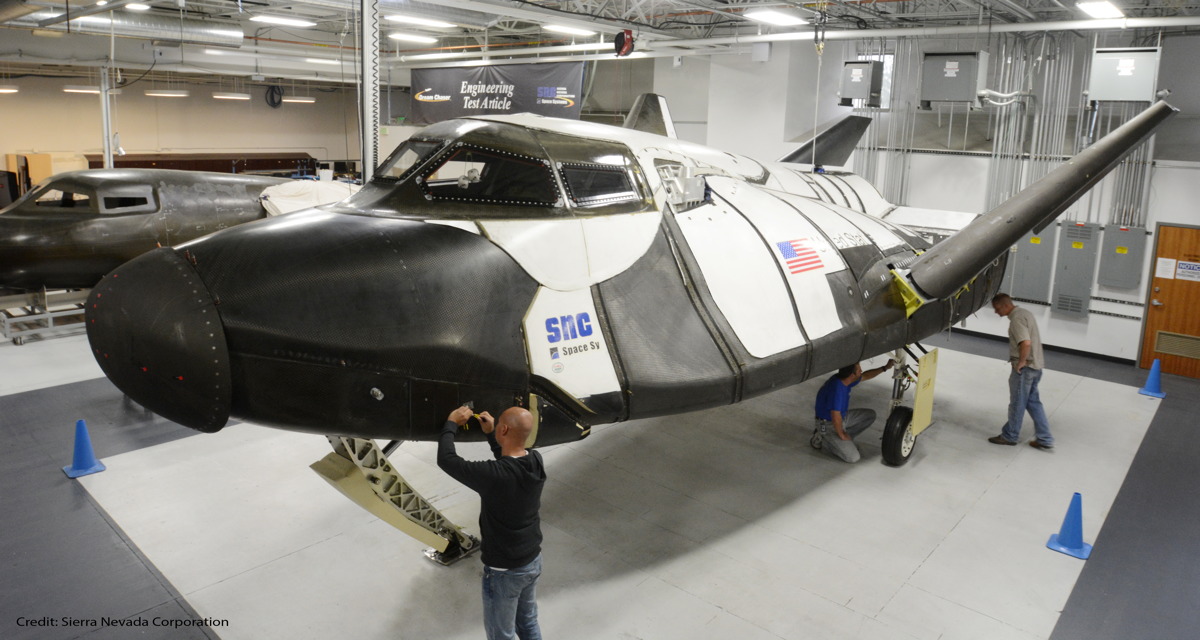Private Dream Chaser Space Plane Poised for New Flight Tests in 2016
LAS CRUCES, New Mexico – A space plane that would continue the legacy of NASA's shuttle program is getting ready for a second stage of flight testing, according to representatives from the Sierra Nevada Corp.
At a gathering of the top leaders and innovators in the commercial spaceflight industry here yesterday (Oct. 7), Mark Sirangelo, corporate vice president of Sierra Nevada's space systems division, discussed the status of the two "Dream Chaser" space planes, which could one day fly astronauts or cargo to the International Space Station or other destinations. The vehicle will begin its second stage of testing at NASA's Armstrong Flight Research Center in early 2016. The NASA research center is located in the Edwards Air Force Base in Southern California.
A video of Dream Chaser's cargo ship role released in March offers a simulation of what the reusable space plane could be capable of. It shows the vehicle — which can operate with a human pilot or autonomously — hitching a ride on a large rocket, then unfurling itself when it reaches space. From there, the vehicle can rendezvous with the space station. [Dream Chaser: A Private Space Plane in Photos]
One version of the Dream Chaser vehicle is a successor to the very first space shuttle, Enterprise, according to Sirangelo. Known as the atmospheric engineering test article (ETA), the version, like NASA's Enterprise, would not actually reach orbit above Earth, but would be able to fly at suborbital altitudes and would serve as a microgravity laboratory. Sierra Nevada announced in September that it was beginning talks with spaceports and commercial airports to find suitable locations for Dream Chaser to land after a mission (the space plane lands horizontally, like NASA's space shuttles).
Sirangelo spoke at a news briefing at the International Symposium for Personal and Commercial Spaceflight (ISPCS), which takes place annually here in Las Cruces. The meeting has become a place for companies and industry members to share updates and ideas about the industry.
In a news release put out by Sierra Nevada Corp. following Sirangelo's talk, the company also announced that it had made progress on the orbital Dream Chaser vehicle (portrayed in the video above). Lockheed Martin, which will manufacture the orbital vehicle, recently completed the first cabin assembly of the orbital space plane.
"Upon completion, the Dream Chaser orbital vehicle will be the most advanced composite structure ever built. We look forward to Dream Chaser becoming the world leader in this area and to its first orbital flight," Sirangelo said in the news release.
Breaking space news, the latest updates on rocket launches, skywatching events and more!
The Sierra Nevada Corp. was one of three companies that received money from NASA as part of the agency's Commercial Crew Integrated Capability (CCiCap) award, which is intended to help companies in the later stages of spacecraft development to reach completion. But Sierra Nevada lost out in the second round of the program, with awards given instead to SpaceX and Boeing. Despite that, the company has pressed on with its development of Dream Chaser.
Follow Calla Cofield @callacofield. Follow us @Spacedotcom, Facebook and Google+. Original article on Space.com.

Calla Cofield joined Space.com's crew in October 2014. She enjoys writing about black holes, exploding stars, ripples in space-time, science in comic books, and all the mysteries of the cosmos. Prior to joining Space.com Calla worked as a freelance writer, with her work appearing in APS News, Symmetry magazine, Scientific American, Nature News, Physics World, and others. From 2010 to 2014 she was a producer for The Physics Central Podcast. Previously, Calla worked at the American Museum of Natural History in New York City (hands down the best office building ever) and SLAC National Accelerator Laboratory in California. Calla studied physics at the University of Massachusetts, Amherst and is originally from Sandy, Utah. In 2018, Calla left Space.com to join NASA's Jet Propulsion Laboratory media team where she oversees astronomy, physics, exoplanets and the Cold Atom Lab mission. She has been underground at three of the largest particle accelerators in the world and would really like to know what the heck dark matter is. Contact Calla via: E-Mail – Twitter


